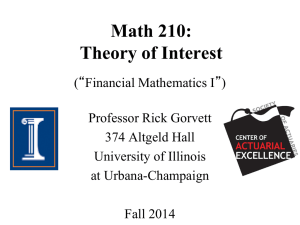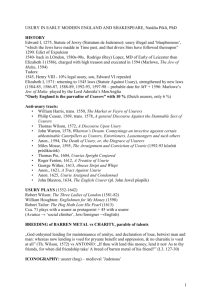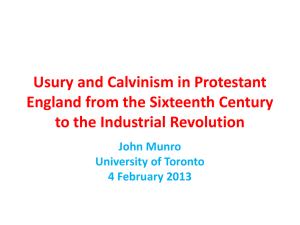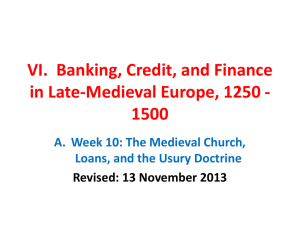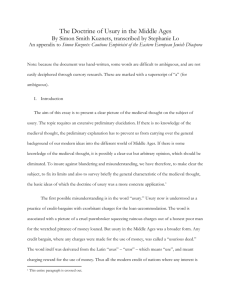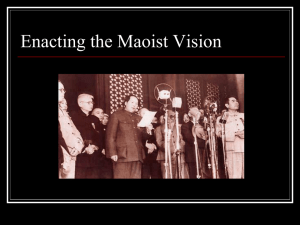Usury and Calvinism in Protestant England
advertisement
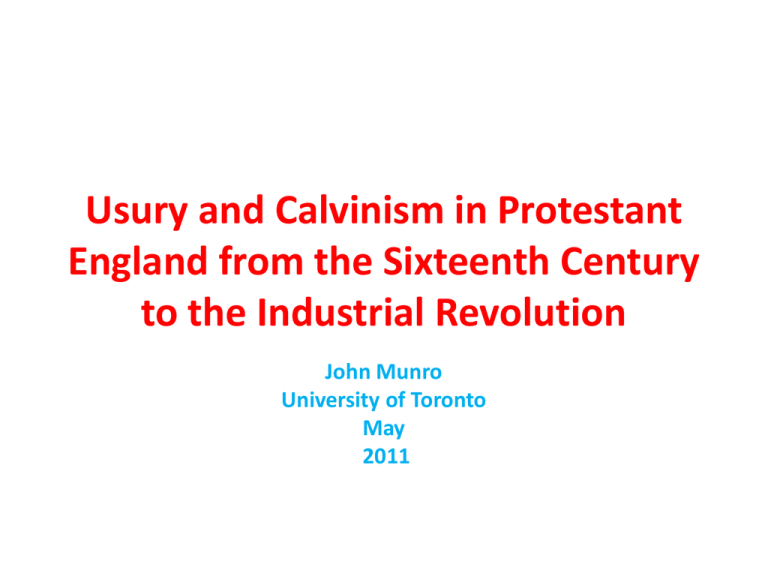
Usury and Calvinism in Protestant England from the Sixteenth Century to the Industrial Revolution John Munro University of Toronto May 2011 Did Usury Ever Matter? • Usury ‘belongs less to economic history than to the history of ideas’. • Charles Kindleberger, A Financial History of Western Europe (London: 1984), p. 41. The Usury Problem in Reformation Europe • One of the many enduring myths on the usury ban: that it ceased to be observed in Reformation Europe • The ecclesiastical usury doctrine: ban against demanding any payment beyond the principal in a loan (mutuum): of money or other fungibles • Such a ban never applied to licit investment returns: • - rent: for use of real estate, other physical property • - profits: from investments in any enterprise • For Protestant England, three major studies have emphasized instead how the early Reformers endorsed and maintained the long-held Scholastic views Major studies on usury in Protestant England • (1) Richard Tawney, Preface to his edition of Thomas Wilson, A Discourse on Usury [1572], published in 1926 • and his Religion and The Rise of Capitalism (1926) • (2) Norman Jones, God and the Moneylenders: Usury and Law in Early Modern England (1989) • (3) Eric Kerridge, Usury, Interest, and the Reformation (2002). • - states that ‘the Protestant reformers were all substantially orthodox concerning usury and interest’, • - that ‘the Reformation made no real substantial changes to fundamental Christian teachings about usury ... or remedies for it, or laws against it’. The evolution of the Christian usury doctrines: Bible and early Christianity • (1) Evolution of usury doctrine: as sin against charity sin against commutative justice sin against Natural Law (against God Himself) • (2) Biblical texts: usury as a sin against charity • - Old Testament (Pentateuch): Exodus 22:25, Leviticus 25: 35-37; Deuteronomy 23: 19-20 • - Old Testament: Ezekiel 18.13 (ca. 580 BCE): He who ‘hath given forth upon usury, and hath taken increase: shall he live? He shall not live – he shall surely die.’ Thus: usury as theft, as a mortal sin. • New Testament: Luke 6:35: ‘lend freely, hoping for nothing again’ • (3) St. Ambrose of Milan (339-97 CE): citing Ezekiel: ‘If someone takes usury, he commits violent robbery (rapina); and he shall not live.’ • - Incorporated into Gratian’s Decretum (canon law): ca. 1135 • (4) Council of Nicea: 325 CE: usury as a sin against charity, applied only to the clergy • (5) Carolingian Church Councils: usury ban applied to all lay persons Evolution of the Scholastic Usury Doctrine (1) • (1) Gratian’s Decretum (concordance of canon law): 1130:1140 : incorporated as well provisions of the Justinian Code (528-542) on the Roman law concept of the loan as a mutuum: ‘what was thine becomes mine’. • - basic principle: a loan transfers ownership of any money (or other fungible commodity) from the borrower to the lender, who has sole rights to its benefits; • - hence usury is theft • - other investment returns, rents and profits, were (as noted) always perfectly licit: because the investor retained equity ownership of his invested capital • (2) Roman Church councils of Lateran III (1179) and IV (1215): harsh penalties for all usurers – excommunication Evolution of the Scholastic Usury Doctrine (2) • (3) Usury is a violation of commutative justice: equality in exchange: in that the lender gains more than the borrower, and steals from the borrower. • (4) 13th-century Scholastic interpretations of reintroduced texts of Aristotle (384-322 BCE) : Nichomachean Ethics (1247, 1260); Politics (1260): • a) that money has only one natural use: as a medium of exchange • b) thus money is inherently sterile: ‘cannot breed’ • c) to lend money at interest is a violation of Natural Law: the most heinous sin against God • (5) ‘Usury is Theft of Time, belonging only to God’ The canonical extrinsic titles: loopholes? • (1) In accordance with principles of commutative justice, canon lawyers permitted the lender to claim compensation if he suffered subsequent loss because of his loans: • a) Mora, or Poena detentori: fines for late payment, beyond stipulated redemption date. • b) Damnum emergens: compensation for the lender’s unanticipated capital losses suffered from fire, theft, war, storms, etc., but only after having made the loan • (2) Lucrum cessans: a rejected title • - a lender’s opportunity cost: in not being able to invest those funds licitly in a rent- or profit-producing asset. • - almost all Scholastics and Reformers rejected this title, because it would mean pre-determined interest Refutation of the Usury Myths • (1) Abhorrence of usury was not just Christian: predated Christianity, and found in much of the non-Christian world to modern times: especially in Islamic societies • (2) Usury applied to all loans: not just charitable loans • (3) Usury did not mean extortionate interest, but all interest: anything beyond the principal of a loan • (4) The canonical Extrinsic Titles were not ‘loopholes’: but legitimate claims to compensation for a lender’s loss that took place only after the loan was in effect • (5) Irrelevant that prosecutions were chiefly for ‘flagrant usurers’ and that interest was easily hidden in a loan: • usury could not be disguised from God (in a society with few atheists -- few who did not fear fires of Hell) The costs of the usury doctrine: high interest rates • Lawrence Stone, The Crisis of the Aristocracy, 15581641 (Oxford, 1965): on Elizabethan & Stuart England • Money will never become freely or cheaply available in a society which nourishes a strong moral prejudice against the taking of any interest at all – as distinct from objections to the taking of extortionate interest. • If usury on any terms, however reasonable, is thought to be a discreditable business, men will tend to shun it, and the few who practise it will demand a high return for being generally regarded as moral lepers. • [Also: risks of prosecution or defaulting debtors] The early Protestant Reformers: the usury doctrine (1) Kerridge, Jones, Tawney, etc., were largely correct in asserting that the Protestant Reformers fully endorsed the Scholastic views: e.g., Luther, Melanchthon, Zwingli [read the texts in the paper] (2) Tawney: Protestant preachers were unceasing in condemning the ‘soul-corrupting’ taint of usury up the Civil War & Commonwealth era (1642-60). (3) Jean Calvin (1509-64): Institutes of the Christian Religion (1536): - Kerridge: ‘Calvin had little to say that was both new and significant’ - completely untrue: Calvin was a major innovator Calvin on usury: ambiguities • (1) Calvin DID permit interest payments, but only on commercial loans: ‘I do not consider that usury be forbidden amongst us, except that it be repugnant to justice and charity’. • (2) Influence of French Catholic jurist: Charles du Moulin (1500-66) • (3) Restrictive conditions: on charging interest • a) that usury never be demanded on any charitable loans • b) that the borrower gain as much as the lender • c) that lending be to the greater good of the Commonwealth • d) that interest rates not exceed any maximum rates established by civil society • 4) Ambiguity in Calvin’s Institutes (1536): ‘it is a very rare thing for a man to be honest and at the same time a usurer’; • - Calvin advocated expulsion of all habitual usurers from the Church • 5) Roger Fenton (1612), an English Puritan Divine: ‘Calvin dealt with usury as the apothecarie doth with poyson’. Jean Calvin (1509-64) Charles Du Moulin (1500 – 1566) 16th- century civil amendments to the Usury legislation • 1) 4 Oct. 1540: Charles V’s ordinance for the Habsburg Netherlands: • - permitted interest payments, but only on commercial loans, up to 12% • - anything beyond that was usury (woekerie; Ger: Wucher) • 2) 1545: Parliament of Henry VIII: permitted interest payments on all loans up to 10% usury above 10% • 3) 1552: Parliament of Edward VI (with radical Protestants) revoked this statute: ‘Forasmuche as Usurie is by the worde of God utterly prohibited, as a vyce moste odyous and destestable’ • 4) 1571: Parliament of Elizabeth I: restored her father’s statute, with the same 10% limitation on interest Subsequent reduction in maximum English interest rates • (1) 10% limit in the 1571 statute: • - taken as both the minimum & maximum interest rate • – 1571 statute implies that Edward VI’s 1552 anti-usury statute, prohibiting all usury, had led to higher interest rates • (2) Early 17th century: Parliamentarians and merchants petitioned for lower maximum interest rates, • - in order to foster commerce and agriculture • - arguments were all economic, no longer religious • (3) Parliament: subsequent reductions in maximum interest rates: • - 1624: to 8% (James I) • - 1651: to 6% (Cromwell); ratified in 1660-61 (Charles II) • - 1713: to 5% (Anne): • - 1854: abolition of the usury laws (Victoria) Economic Consequences of the Usury Legislation: 1540 - 1713 • (1) Significant reductions in market rates of interest – 16th to 18th century: evidence from the Low Countries & England: from 30% to 8% to 5% • reduced the costs of capital formation • greater commercial & economic expansion • (2) Commercial bills: introduction and spread of discounting negotiability (with endorsement) • (3) Government finances: shift from loans (bonds) to annuities (rentes) for public finances Discounting Bills of Exchange (1) • (1) Medieval bills of exchange: allowed merchants to include or ‘disguise’ interest charges within exchange rates• not usurious in eyes of Church: viewed as licit purchases of foreign bank balances, with uncertain returns (i.e., future rates on the recambium or return bills); • but ‘dry exchange’ was usurious (fixing rates at outset) • (2) Medieval usury ban, however, made bills nonnegotiable, so that bills had to be held until maturity (though could be transferred at face maturity value) • (3) Discounting: essence of negotiability: i.e., selling a bill for cash or goods before due date and necessarily at a discount would have revealed implicit interest. Discounting Bills of Exchange (2) • (4) Introduction and spread of discounting, with full negotiability, via bearer bills or endorsement: from mid to late 16th & 17th centuries. • (5) Evidence for Low Countries and England: that discounting (& endorsement) spread and became widely accepted only after legislation had permitted interest payments (as noted before). • (6) Law merchant courts in England (1437) and Low Countries (1506) provided legal enforcement of payment claims for third parties to whom negotiable bills had been transferred (as bearer or endorsed bills). • - Habsburg Netherlands: imperial edicts: 1537, 1541 Discounting Bills of Exchange (3) • (7) Importance of discounting for the British Industrial Revolution: ca. 1760 - 1830 • a) primary role of English & Scottish banks: in discounting foreign, domestic (‘inland’) bills and promissory notes provided most of the working capital needs of industry and commerce • b) discounting ‘acceptance’ bills (name for bills of exchange from the 17th century): primary mechanism for financing foreign trade to the present day key to global economic growth The ‘Financial Revolution’: Rentes or annuities for state finances • 1) English Financial Revolution: following the Glorious Revolution of 1688: • Parliament deposed Catholic James II and replaced him with Dutch Calvinist prince William III (& Mary) imported Dutch financial system • 2) Permanent funded national debt based on the sale of perpetual annuities (rentes) instead of interest-bearing bonds: from 1693 to 1757 • 3) Thus immune to the current usury legislation with falling maximum interest rates Medieval Origins of the Financial Revolution: Rentes • (1) Early 13th century: vigorous revival & intensification of the antiusury campaign: conducted by Franciscans & Dominicans (new mendicant preaching orders) veritable ‘reign of terror’ • (2) Many merchants and town governments in northern France and Flanders, fearing for their mortal souls, refused to engage in usurious loans instead chose to finance towns governments by sale/purchase of rentes (annuities) provoked opposition from theologians as a ‘cloak for usury’. • (3) Pope Innocent IV: 1250: ruled that no usury was involved, since those buying annuities could never demand redemption (but issuers could redeem them); merely buying future income-streams • (4) Theological disputes ended in 15th century with three papal bulls upholding views of Innocent IV: especially on redemptions (at par nominal values, by the state or issuer only) The Financial Revolution and the British Industrial Revolution (1) • (1) By 16th century, sales of life- and perpetual-rentes had become the mainstay of public finances in most of Western Europe • (2) State finances based on rentes most highly evolved in the 16thcentury Habsburg Netherlands (& Spain) adopted by the new Dutch Republic (from 1580s) transmitted to England after Glorious Revolution of 1688 • (3) Chief English difference: from 1720, based entirely on perpetual & negotiable annuities (vs. the more common Dutch life-rents) • (4) Reduced cost of English state borrowing: • - from 14% in 1693: with Million Pound Loan (a lifetime annuity) • - to 3% in 1757, with completion of Pelham’s Conversion of the entire national debt, begun in 1749, into the Consolidated Stock of the Nation = ‘Consols’ (2.75% from 1888; and 2.50% from 1903, to the present day: on the LSE). The Financial Revolution and the British Industrial Revolution (2) • (4) Importance in fall of government interest rates: • - allowed Great Britain to finance both ‘guns and butter’ with its many 18th-century wars (to 1815) • reduced or eliminated ‘crowding out’ effects, so that private capital investments were not impeded • (5) Importance of Consols as the prime negotiable financial instrument: trading on the Amsterdam Beurs and the London Stock Exchange • - became a universally popular investment and as such the chief form of collateral, along with land, for long-term loans to finance fixed capital formation The Financial Revolution and the British Industrial Revolution (3) • (6) Evolution of legal and financial institutions for full-fledged, legally enforced negotiability, to protect property rights of third parties claiming financial assets: also vitally important, but a separate story (also for stock exchanges) • (7) These legal-institutional factors providing full negotiability, along with discounting & endorsement, and state-financing with annuities: constituted a veritable financial revolution that helped make possible the British Industrial Revolution. Appendix: Aristotle on Usury: ‘Politics’ • The most hated sort [of money-making], and with the greatest reason, is usury, which makes a gain out of money itself, and not from the natural use of it. For money was intended to be used in exchange, but not to increase at interest. • And this term usury [τόκος], which means the birth of money from money, is applied to the breeding of money because the offspring resembles the parent. Whereof of all modes of making money this is the most unnatural. St. Thomas Aquinas on Fungibles and the Usury Doctrine (1) • (1) fungible: • - a commodity that can be replaced by any other identical commodity: non-differentiated: e.g., paper clips (or sheaves of wheat, flagons of wine & oil) • coins: gold and silver: undifferentiated by denomination, so that one replaced by another, i.e., as a fungible • ‘consumption in use fungibles’: any such fungible commodity is necessarily consumed in its use and can thus be replaced only by an exact replica: • (2) non-fungibles: • - commodities with individual defining characteristics, which are also not consumed in their use: • e.g., a piece of land, a house, a barn, a horse, ox, a plough St. Thomas Aquinas on Fungibles and the Usury Doctrine (2) • (3) Aquinas: distinction between loan of fungibles and non-fungibles. • (a) a loan of a fungible is to be repaid in the exact same amount (quantity) of other but the same identical replacement (replica) commodity, • (b) but a non-fungible is to be returned, as the very same commodity: for which a rent may be charged for the use of that commodity, and for deterioration • (4) this concept has the same intellectual foundation as the ‘transfer of ownership’ concept, which applies only to a mutuum – and thus not to property rentals (in which ownership is not transferred Dilbert on Fungibles
